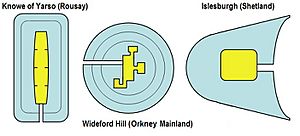Heel-shaped cairn facts for kids
A heel-shaped cairn is a special kind of ancient stone monument. It's like a big pile of rocks built a very long time ago. These cairns are mostly found in Scotland, especially in places like Caithness, Sutherland, and the Shetland Islands. In Orkney, there's only one similar site called the Isbister Cairn.
These cairns get their name because they look a bit like the heel of a shoe. They usually have a round base made of broken rocks. Around the front, there's often a flat area or platform. This platform can be up to 20 meters (about 65 feet) wide. It's also about 1 to 1.5 meters (3 to 5 feet) high. Large stones called kerbstones often line the edge of this platform. The front of the cairn usually has a curved, indented shape called an exedra.
Inside these cairns, there are special rooms or "chambers." These chambers often have a cross shape, which is called "cruciform." You get into them through a short passage. The main room usually has a large alcove at one end and two smaller ones on the sides. The ceilings of these chambers were built using a technique called a corbelled vault. This means stones were stacked inward, getting closer together until they met at the top. Today, often only parts of these ancient ceilings remain.
Famous Heel-Shaped Cairns
Many heel-shaped cairns are found in the Shetland Islands. Some well-known examples include:
- Gillaburn
- Hill of Caldback
- Hill of Dale
- Mangaster
- Muckle Heog
- Pettigarth’s Field
- Punds Water
- Turdale Water
- Vementry
- Viville Loch
- Ward of Silwicks
- Wind Hamars
One interesting heel-shaped cairn is Cairn o’ Get. It's also known as Garrywhin. This cairn looks like a round cairn that was later covered by a "horned long cairn." It has a circular chamber inside. Another example is the monument at Vementry. Here, a round cairn with a typical heel-shaped chamber was later built over. It was given a large exedra about 10.6 meters (35 feet) wide at the front.
Learning More
If you want to learn more about these fascinating ancient structures, you can check out books by experts like Audrey S. Henshall and Graham Ritchie. They have written detailed studies about the chambered cairns in Scotland.


